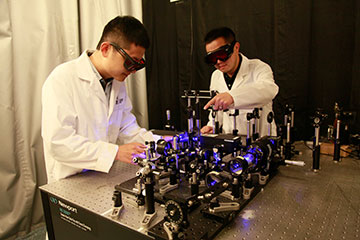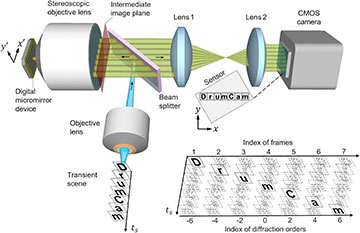
Jinyang Liang and Xianglei Liu (pictured) at the Université du Québec, Canada, are part of a group that has developed a diffraction-based camera able to image dynamic processes in a single exposure at 4.8 million frames per second. [Image: Xianglei Liu and Jinyang Liang, Institut National de la Recherche Scientifique (INRS)]
Scientists in Canada and the United States have exploited the phenomenon of diffraction to develop a new kind of ultrafast photography that yields several million frames per second (Optica, doi: 10.1364/OPTICA.495041). Demonstrating a camera made from off-the-shelf parts, the researchers say that their approach should cost about an order of magnitude less than current high-speed imaging technology. They reckon it could be applied to everything from disease detection to laser ranging.
DRUM cameras
A technique known as single-shot high-speed mapping photography avoids the high cost and low sensitivity of very fast CCD sensors or CMOS cameras by breaking down, or “gating,” single exposures into shorter segments and mapping those segments to different spatial positions on the detector. One popular option implements gating via beam splitting, but this approach sacrifices light throughput for speed and would likely be costly and complex to scale up.
Alternatively, information can be transferred from the temporal to spatial domains by exploiting the properties of certain intermediate tags, such as the dispersion of different wavelengths or the varying angles of incident light. But again, each of these approaches has its drawbacks—representing time via wavelength lowers temporal resolution, as the spectrum is chopped up into more pieces, while relying on angle could lead to parallax errors.
In the latest work, Jinyang Liang and colleagues at the Institut National de la Recherche Scientifique (INRS) of the Université du Québec, Canada, working with researchers at Concordia University, Canada, and Meta Platforms, USA, instead develop what they call diffraction-gated real-time ultrahigh-speed mapping (DRUM). They do so by exploiting a digital micromirror device (DMD), a rectangular array of several hundred thousand microscopic mirrors used in commercial projectors. The device generates light and dark pixels by slightly rotating the mirrors so that they direct light from a bulb toward or away from a lens.
Making DMD movies
Schematic and operating principle of DRUM photography. A synthetic scene composed of seven letters, “DrumCam,” at different times is used to illustrate the system’s operating principle, with ts as the time of the dynamic scene. [Image: X. Liu et al., doi: 10.1364/OPTICA.495041] [Enlarge image]
Rather than using a DMD as a projector, the researchers instead exploit it for movie making. The array acts like a diffraction grating that at any given point in time reflects most incoming light into one particular diffraction order, and is programmed so that at successive points in time, the mirrors flip to concentrate light into adjacent orders. In this way, a series of images in time can be split up across space and then captured by a suitably large detector.
In their demonstration, Liang and colleagues used a blue, 473 nm continuous-wave laser to illuminate a fast-changing scene, and they employed a beam splitter and several lenses to direct the temporally encoded light to the DMD before sending the resultant spatially encoded light to a CMOS camera.
The researchers point out that the speed of imaging depends on several factors, among them the rate at which they can switch the micromirrors and the frequency of light that they use, with higher frequencies corresponding to more tightly packed diffraction orders. They were able to clearly distinguish seven distinct diffraction orders and needed just 1.5 microseconds to switch the mirrors, so they found that they could generate frames at a rate of 4.8 million per second.
Speed tests on water and onions
To demonstrate the potential of DRUM, the researchers used it to observe how femtosecond laser pulses ionize a sample of distilled water. Over the course of just a few microseconds, they were able to image the appearance of a plasma channel, the channel’s progressive shortening and disappearance and finally the appearance of a bubble in the plasma. Then, by slightly increasing the femtosecond pump energy, they showed that they could generate a much larger bubble—an increase in radius that agreed well with the predictions of fluid dynamics.
What’s more, Liang and coworkers found that their new camera could also track the microsecond-scale response of a biological sample—a single layer of onion cells—to femtosecond laser pulses. They showed how the pulses ablated the cells, tracking in detail the changing size and shape of the damaged area.
They say that this capability could be exploited in medical procedures that destroy hardened tissue like kidney stones or gallstones, as well as being suited to nanoscale surgery. They note that other potential medical applications include ultrasound-stimulated molecular detection of disease and therapeutic drug delivery. Outside medicine, they say that their technique could benefit lidar by updating depth maps at high rates, allowing vehicles to detect dangers more quickly.
Lower-cost option
The researchers believe that a DRUM system could be sold for less than US$10,000, which would make it more than 10 times cheaper than existing commercial products with similar imaging speeds. And they say that it could be improved further by using a shorter-wavelength laser and faster mirror flipping. Indeed, they add that their technique could be applied to more powerful micromirror technologies, such as one-dimensional MEMS arrays that flip mirrors on the scale of nanoseconds, potentially yielding imaging at the rate of a billion frames per second.
However, they acknowledge that they face a hurdle when it comes to detector technology. In their current setup, they capture the seven diffraction orders by aligning the image along the CMOS camera’s diagonal axis. Improving frame rate while maintaining signal-to-noise ratio will require large, highly pixelated and very sensitive sensors, they say, which are commercially available but could at least double the price of the device.

